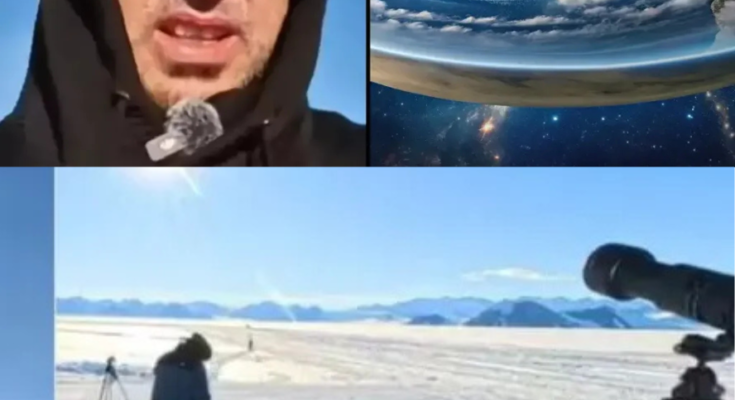Jeran Campanella, a prominent figure within the Flat Earth movement, gained attention for his steadfast belief that the Earth was flat. He built a large following, spreading the idea that mainstream science was misleading the public about the shape of the Earth. However, in an unexpected turn, Campanella decided to embark on a journey to Antarctica in an effort to conclusively prove the Flat Earth theory.
His expedition was framed as a critical piece of evidence in the ongoing debate about the shape of the Earth. He intended to capture firsthand proof that the Earth was flat by studying the behavior of the sun in Antarctica. According to Flat Earth theory, the sun should behave in a manner consistent with a flat, stationary Earth, providing visual confirmation to support their beliefs.
Campanella, alongside other Flat Earthers, focused on the 24-hour daylight phenomenon that occurs in Antarctica. During certain periods of the year, the sun remains visible for 24 hours in regions of Antarctica, and the Flat Earth community believed this was a critical piece of evidence that could be interpreted as supporting their views. They theorized that the sun’s apparent behavior in these regions could only be explained by a flat Earth model.

But when Campanella arrived in Antarctica and observed the sun for himself, something unexpected happened. Rather than reinforcing his pre-existing beliefs, the experience challenged everything he thought he knew about the Earth. The behavior of the sun in Antarctica did not align with the predictions or expectations set forth by Flat Earth theory. Instead, it was consistent with what scientists had long claimed: the Earth is round.
In his reflection on the experience, Campanella admitted that he had been wrong. He acknowledged that the evidence presented by the sun’s movement and the conditions he observed in Antarctica could only be explained by the Earth being spherical. This revelation marked a dramatic shift in his perspective, as he openly admitted his prior beliefs were based on misconceptions.
For Campanella, the journey to Antarctica wasn’t just a physical trip to the southernmost part of the world, but a profound intellectual journey as well. His decision to travel there was not only a personal exploration of an idea he had championed but also an attempt to challenge the scientific consensus on the shape of the Earth. The outcome, however, did not align with his expectations, leading him to publicly change his stance.
This moment in the Flat Earth movement is significant because it showcases how direct, firsthand evidence can challenge long-held beliefs. For those who have spent years advocating for a flat Earth, Campanella’s shift represents a powerful reminder that the pursuit of truth and understanding is often more complex than adhering to a single ideology or theory. His change of heart also highlights the importance of critical thinking and the willingness to accept new information, even when it contradicts previous assumptions.
Campanella’s experience in Antarctica is an important example of how individuals can change their views when confronted with compelling evidence. It also underscores the role of personal exploration in the search for truth, suggesting that sometimes the best way to understand the world is through firsthand experience rather than relying on secondary sources or preconceived ideas.

In the end, Campanella’s story serves as a reminder that science is not static; it evolves and adapts as new information and evidence come to light. For those who have been entrenched in Flat Earth beliefs, his journey serves as a powerful example of how the pursuit of truth can lead to surprising and life-changing revelations.
It also emphasizes that while questioning established knowledge is important, it is equally important to remain open to the possibility that those established ideas are correct, and that personal experience and evidence can lead to a greater understanding of the world around us.
For Campanella, what began as an attempt to prove the Flat Earth theory ended with a humbling realization that the Earth is indeed round, shifting his views and, in many ways, changing the course of his personal journey. His story serves as an example of the transformative power of self-discovery, and the impact that one trip to the ends of the Earth can have on altering deeply held convictions.



